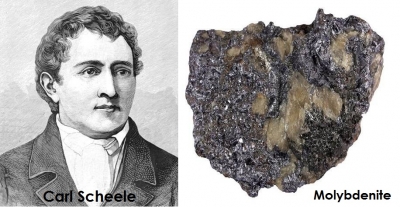
The mineral molybdenite (molybdenum sulphide) was often mistaken for graphite or lead ore until 1778. This soft black mineral was analyzed by German chemist Carl Scheele, who discovered that it was neither of these substances, and that it was a totally new element. But Scheele did not have a suitable furnace to reduce the mineral to a metal. As a result, it took a few more years until it was actually identified. Although Scheele made a number of chemical discoveries such as oxygen, the credit was always given to someone else because he couldn’t come to a final analysis. As a result, he later became known as “hard luck Scheele”.
For many years, scientists continued to assume that molybdenite had a new element, but they could not reduce the mineral to the metal and isolate it. Later, Peter Jacob Hjelm, a Swedish chemist, ground molybdic acid with carbon in linseed oil to form a paste. Then he allowed this paste to be in close contact with carbon and the molybdenite. This mixture was then heated in a closed crucible to produce the metal. He named it molybdenum (atomic number 42) after the Greek word “molybdos”, which means lead. According to the Royal Society of Chemistry, this new element was announced in the autumn of 1781.
Molybdenum has silvery-white appearance and it is ductile and highly resistant to corrosion. It also has one of the highest melting points of all pure elements. Only tantalum and tungsten have higher melting points than molybdenum. This element is also a micronutrient that is essential for life.
Picture Credit : Google




